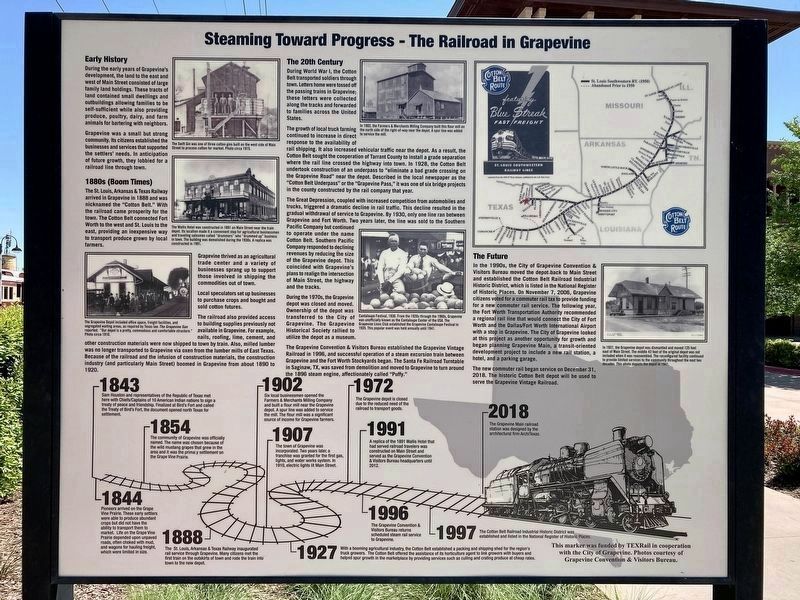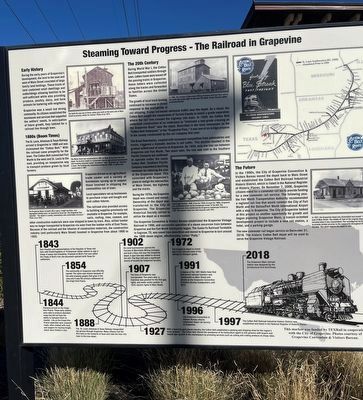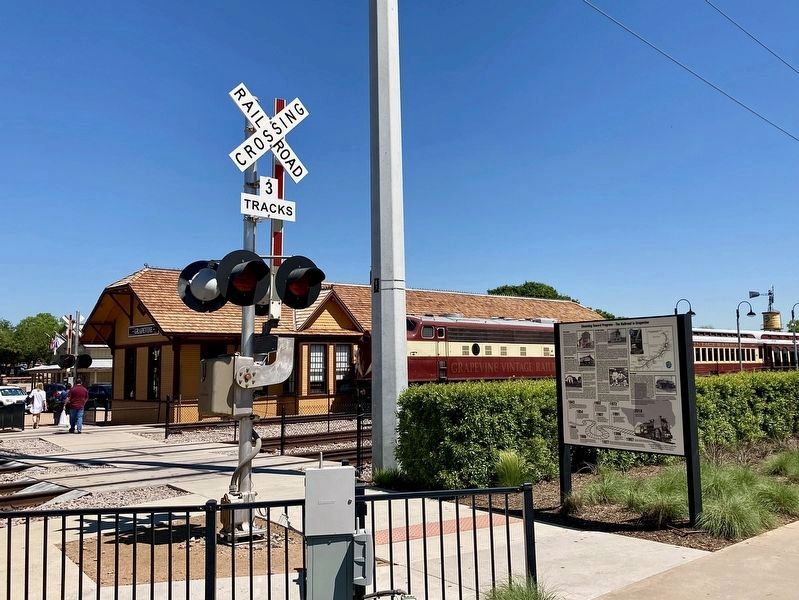Grapevine in Tarrant County, Texas — The American South (West South Central)
Steaming Toward Progress - The Railroad in Grapevine
Early History
During the early years of Grapevine's development, the land to the east and west of Main Street consisted of large family land holdings. These tracts of land contained small dwellings and outbuildings allowing families to be self-sufficient while also providing produce, poultry, dairy, and farm animals for bartering with neighbors.
Grapevine was a small but strong community. Its citizens established the businesses and services that supported the settlers' needs. In anticipation of future growth, they lobbied for a railroad line through town.
1880s (Boom Times)
The St. Louis, Arkansas & Texas Railway arrived in Grapevine in 1888 and was nicknamed the "Cotton Belt." With the railroad came prosperity for the town. The Cotton Bell connected Fort Worth to the west and St. Louis to the east, providing an inexpensive way to transport produce grown by local farmers.
Grapevine thrived as an agricultural trade center and a variety of businesses sprang up to support those involved in shipping the commodities out of town.
Local speculators set up businesses to purchase crops and bought and sold cotton futures.
The railroad also provided access to building supplies previously not available in Grapevine. For example, nails, roofing, lime, cement, and other construction materials were now shipped to town by train. Also, milled lumber was no longer transported to Grapevine via oxen from the lumber mills of East Texas. Because of the railroad and the infusion of construction materials, the construction industry (and particularly Main Street) boomed in Grapevine from about 1890 to 1920.
The 20th Century
During World War I, the Cotton Belt transported soldiers through town. Letters home were tossed off the passing trains in Grapevine; these letters were collected along the tracks and forwarded to families across the United States.
The growth of local truck farming continued to increase in direct response to the availability of rail shipping. It also increased vehicular traffic near the depot. As a result, the Cotton Belt sought the cooperation of Tarrant County to install a grade separation where the rail line crossed the highway into town. In 1928, the Cotton Bell undertook construction of an underpass to "eliminate a bad grade crossing on the Grapevine Road” near the depot. Described in the local newspaper as the "Cotton Belt Underpass" or the "Grapevine Pass," it was one of six bridge projects in the county constructed by the rail company that year.
The Great Depression, coupled with increased competition from automobiles and trucks, triggered
a dramatic decline in rail traffic. This decline resulted in the gradual withdrawal of service to Grapevine. By 1930, only one line ran between Grapevine and Fort Worth. Two years later, the line was sold to the Southern Pacific Company but continued to operate under the name Cotton Belt. Southern Pacific Company responded to declining revenues by reducing the size of the Grapevine depot. This
coincided with Grapevine's plans to realign the intersection of Main Street, the highway and the tracks.
During the 1970s, the Grapevine depot was closed and moved. Ownership of the depot was transferred to the City of Grapevine. The Grapevine Historical Society rallied to utilize the depot as a museum.
The Grapevine Convention & Visitors Bureau established the Grapevine Vintage Railroad in 1996, and successful operation of a steam excursion train between Grapevine and the Fort Worth Stockyards began. The Santa Fe Railroad Turntable in Saginaw, TX, was saved from demolition and moved to Grapevine to turn around the 1896 steam engine, affectionately called "Putty."
The Future
In the 1990s, the City of Grapevine Convention & Visitors Bureau moved the depot back to Main Street and established the Cotton Belt Railroad Industrial Historic District, which is listed in the National Register of Historic Places. On November 7, 2006, Grapevine citizens voted for a commuter rail tax to provide funding for a new commuter rail service. The following year, the Fort Worth Transportation Authority recommended a regional rail line that would connect the City of Fort Worth and the Dallas/Fort Worth International Airport with a stop in Grapevine. The City of Grapevine looked at this project as another opportunity for growth and began planning Grapevine Main, a transit-oriented development project to include a new rail station, a hotel, and a parking garage.
The new commuter rail began service on December 31, 2018. The historic Cotton Belt depot will be used to serve the Grapevine Vintage Railroad.
1843
Sam Houston and representatives of the Republic of Texas met here with Chief/Captains of 10 American Indian Nations to sign a treaty of peace and friendship. Finalized at Bird's Fort, and called the Treaty of Bird's Fort, the document opened north Texas for settlement.
1844
Pioneers arrived on the Grape Vine Prairie. These early settlers were able to produce abundant crops but did not have the ability to transport them to market. Life on the Grape Vine Prairie depended upon unpaved roads, often choked with mud, and wagons for hauling freight, which were limited in size.
1854
The community of Grapevine was officially named. The name was chosen because of the wild mustang grapes that grew in the area and it was the primary settlement on the Grape Vine Prairie.
1888
The St. Louis & Texas railway inaugurated rail service through Grapevine. Many citizens met the first train on the outskirts of town and rode the train into town to the new depot.
1902
Six local businessmen opened the Farmers & Merchant Company and built a flour mill near the Grapevine depot. A spur line was added to service the mill. The Flour mill was a significant source of income for Grapevine farmers.
1907
The town of Grapevine incorporated. Two year later a franchise was granted for the first gas lights, and water works system. In 1910, electric lights lit main Street.
1927
With a booming agriculture industry, the Cotton Belt established a packing and shipping shed for the region's truck growers. The Cotton Belt offered the assistance of its horticulture agent to link growers with buyers and helped spur growth in the market place by providing services as culling and crafting produce at cheap rates.
1972
The Grapevine depot is closed due to the reduced need of the railroad to transport goods.
1991
A replica of the 1891 the Wallis Hotel that had served railroad travelers was constructed on Main Street and served as the Grapevine Convention & Vistors Bureau headquarters until 2012.
1997
The Cotton Belt Railroad Industrial Historic district was established and listed in the national register of Historic Places.
2018
The Grapevine Main railroad station was designed by the architectural firm ArchiTexas.
Captions
Upper Left: The Swift Gin was one of three cotton gins built on the west side of Main Street to process cotton for market. Photo circa 1915.
Middle Left: The Wallis Hotel was constructed in 1891 on Main Street near the train depot. Its location made it a convenient stop for agricultural businessmen and traveling salesmen called "drummers" who "drummed up" business in town. The building was demolished during the 1930s. A replica was constructed in 1991.
Lower Left: The Grapevine Depot included office space, freight facilities, and segregated waiting areas, as required by Texas law. The Grapevine Sun reported: "Our depot is a pretty, commodious and comfortable structure." Photo circa 1910.
Upper Middle: In 1902, the Farmers & Merchants Milling Company built this flour mill on the north side of the right of way near the depot. A spur line was added to service the mill.
Center: Cantaloupe Festival, 1936. From the 1920s through the 1960s, Grapevine was unofficially known as the Cantaloupe Center of the USA. The Grapevine Lions Club established the Grapevine Cantaloupe Festival in 1935. This popular event was held annually until 1941.
Lower Right: In 1937, the Grapevine depot was dismantled and moved...east of Main Street. The middle 42 feet of the original depot...included when it was reassembled. The reconfigured facility...to provide limited services to the community throughout the...decades. This photo depicts the depot in 1941.
Photos courtesy of Grapevine Convention & Visitors Bureau.
Erected by TEXRail and City of Grapevine.
Topics. This historical marker is listed in this topic list: Railroads & Streetcars.
Location. 32° 56.01′ N, 97° 4.69′ W. Marker is in Grapevine, Texas, in Tarrant County. Marker is on Main Street near Dallas Street, on the left when traveling south. Touch for map. Marker is at or near this postal address: 707 S Main Street, Grapevine TX 76051, United States of America. Touch for directions.
Other nearby markers. At least 8 other markers are within walking distance of this marker. Courage, Sacrifice (within shouting distance of this marker); "Coming Home" (within shouting distance of this marker); A Sentinel to Safety (within shouting distance of this marker); The Cotton Belt Railroad Depot (within shouting distance of this marker); The Grapevine Mill (within shouting distance of this marker); Peace Circle (within shouting distance of this marker); Willy Majors (within shouting distance of this marker); The Founders Building (within shouting distance of this marker). Touch for a list and map of all markers in Grapevine.
Credits. This page was last revised on April 6, 2024. It was originally submitted on November 2, 2023, by Thomas Smith of Waterloo, Ill. This page has been viewed 349 times since then and 34 times this year. Photos: 1. submitted on April 6, 2024, by Craig Baker of Sylmar, California. 2. submitted on November 2, 2023, by Thomas Smith of Waterloo, Ill. 3. submitted on April 6, 2024, by Craig Baker of Sylmar, California. • James Hulse was the editor who published this page.


